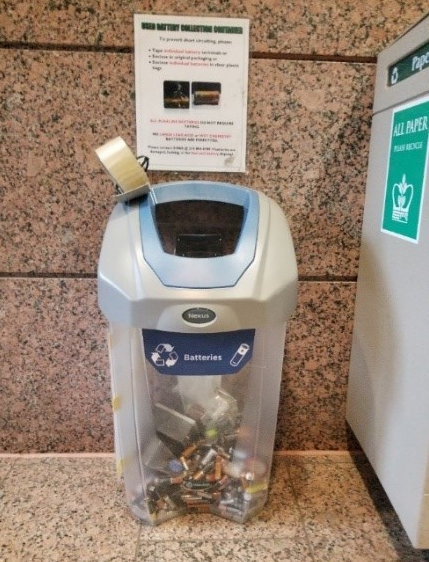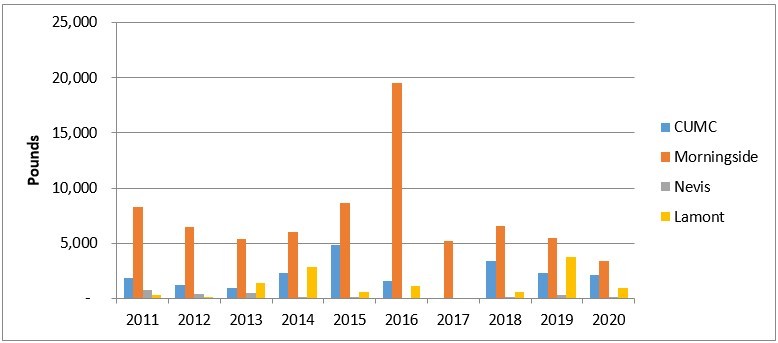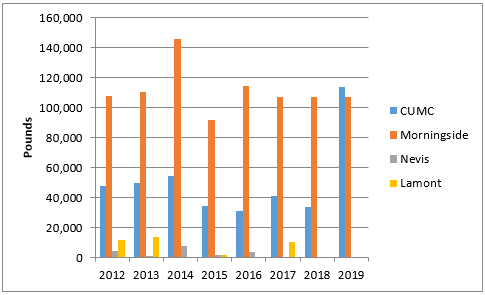Recycling and Universal Waste Management

Batteries have become an essential part of our lives. Whether disposable or rechargeable, batteries are ubiquitous and an integral component of many electronic devices and systems that we use daily and can’t seem to do without any longer. Smart phones, personal computers, and many hand tools, operate on batteries or battery back-up devices. The convenience of the battery is portability. The danger of the battery is the potential for environmental harm. Current battery technology often incorporates the use of a variety of toxic metals (e.g., lead, mercury, cadmium) and/or corrosive chemicals (e.g., sulfuric acid) to make batteries function. The proliferation of battery usage combined with EH&S’s mission of reducing the environmental impact of the University’s operations, prompted us to make battery recycling available to the University community with the installation of battery recycling receptacles throughout many campus buildings
Historically, EH&S collected batteries form laboratories and Facilities Management through the University’s Hazardous Waste Management Program. Since its inception in 2001, EH&S’s battery recycling program has grown both in the number of battery recycling receptacles and in pounds of materials collected for recycling. EH&S has collected more than 93,295 pounds (more than 42 metric tons) of batteries for recycling. Below is sample data from our recycling efforts since 2011.

This program continues to progress, as new and interesting recycling technologies become available. Additionally, EH&S continued to install tape dispensers at all locations to provide the Columbia community with a means to protect battery terminals to prevent batteries from short circuiting and generating heat. We encourage everyone to recycle their batteries, regardless of battery type in a safe and responsible manner. Please DO NOT place damaged, leaking or bulging batteries, or large lead acid batteries in the receptacles as they can be very dangerous to handle. Instead, contact EH&S by phone or via the electronic waste pick-up request available on the EH&S website.
Federal regulations require changes to the disposal process of batteries in the recycling containers on campus. There is one easy, but critical step necessary prior to depositing batteries into the recycling containers: taping the terminals.
To prevent short circuit ensure the terminals cannot come into contact with other terminals, batteries, or metal objects by placing clear tape over the battery terminals, using the original battery packaging, or individually bagging each battery. Additionally, alkaline batteries do not require battery terminal protection, so you can deposit these batteries “as-is” in our conveniently located collection centers.
As technology continues to change rapidly, electronic devices such as computers, smart phones, and television sets are becoming obsolete at an increasingly faster rate. Since electronic devices often contain hazardous materials and toxic metals, recycling them helps to protect the environment.
How to recycle Used Electronics at Columbia University
There are many pathways to properly recycling your computer equipment at Columbia University. To arrange for a pick-up of electronics by campus:
- Morningside: call 212-854-2222 Facilities
- Medical Center & Manhattanville: call 212-305-HELP (4357) extension 3
- Nevis Campus: call 914-591-8883 Facilities
- Lamont-Doherty Earth Observatory: call 845-365-8860 the Safety and Security Department
*It is important to be aware that before a computer is designated for recycling or repurposing, it is the responsibility of the end user to ensure that sensitive data are cleansed from the hard drive. Deleting files or simply reformatting the hard drive will not stop someone intent on recovering private, personal or confidential data from your computer. Data cleaning options:
- CUIT’s “Data Sanitization/Disposal of Electronic Equipment Policy” outlines the procedure for cleansing electronic equipment of sensitive data
- CUIT also provides the Columbia community with DBAN https://cuit.columbia.edu/physical-security, an easy to use program that erases all data from a hard drive
In addition to routine pick-up requests, the Morningside and Nevis campuses host a couple of recycling events throughout the year, such as Clean & Go Green for faculty and staff, and Give & Go Green for students during the spring move out. If you have any further questions regarding electronics recycling, please contact EH&S at [email protected].
Since its inception, EH&S's computer recycling program has grown both in the number of computers collected and in pounds of materials recycled. To date, EH&S has collected close to 1,685,917 pounds (approximately 843 tons) of electronics for recycling. Below is data from our recent recycling efforts

For more information on reuse, recycling, or environmental issues about electronic recycling, please visit:
https://www1.nyc.gov/assets/dsny/site/services/recycling
http://www.dec.ny.gov/chemical/8788.html
Glassware is a common waste from research laboratories. If uncontaminated, glassware can be recycled as opposed to disposed of in landfills or incinerators. During the implementation of the Chemical Tracking System (ChemTracker) at Morningside in the summer of 2006, EH&S identified an opportunity to increase laboratory glassware recycling in the Department of Chemistry. Due to the nature of some of the research in Chemistry, tons of “contaminated” glassware were managed by EH&S through the Hazardous Waste Management Program each year. This glassware was perceived as grossly contaminated and a hazardous waste incinerator was the disposal outlet of choice. ChemTracker, which served as the impetus for all laboratories to manage their chemical inventories and the resultant empty laboratory chemical containers in a consistent fashion, also enabled EH&S work with the laboratories to establish better source segregation practices at the point of generation. As a result, the tons of “contaminated” glassware traditionally handled through the Hazardous Waste Management Program were reduced and a significant volume of uncontaminated glassware was redirected for recycling.
Not all laboratory glassware is suitable for recycling. To help the laboratories determine which glassware can be recycled, EH&S prepared some general guidance for the laboratories to follow. In general, empty bar-coded chemical containers should be rinsed, defaced of their labels and placed into a yellow chemical collection bin so they can be scanned out of the ChemTracker system and properly recycled. Unwanted clean laboratory glassware should be discarded in a cardboard box designed for broken glass collection and recycling. Grossly contaminated glassware must still be collected in the blue bins for disposal through the Hazardous Waste Management Program.
Since the program’s inception in September 2006, we have been diverting approximately 50% of our overall glassware waste from landfills and incinerators to recycling facilities. This has translated into a 40% reduction in expenses for glassware disposal, which is proof that going green does not always cost more.
What to do with cardboard glass recycling containers when they are full…
Uncontaminated glassware should be packaged and sealed in cardboard boxes (either boxes designed specifically for disposable glassware or other empty boxes) and left for your campus’ Facilities Operation Office to collect and deliver to the glass recycling staging area. Please visit the “Laboratory Container and Glassware Management Policy” link for guidance.
Last but not least…
Please be part of Columbia University’s effort and commitment to the environment by recycling your uncontaminated glassware. It’s simple: if you use glassware make sure you have a cardboard glass bin in your laboratory, this bin will be recycled. If you have questions regarding what can be recycled and what can’t, refer to our glass management chart or ask a Hazardous Materials Officer.
Solvent Recycling…Then and Now
Columbia University was awarded the Environmental Excellence Award from the New York State Department of Environmental Conservation in 2014 for the laboratory solvent recycling program at the Medical Center and Morningside campuses. Solvent recycling launched in early 2001, as the results of a partnership between EH&S and the departments of Dermatopathology and Pathology, focused on creating an environmentally sustainable program to reduce chemical waste, as well as annual expenses.
EH&S targeted ethyl alcohol and xylene in a variety of tissue-processing and staining procedures, due to their consistent, high volume use. Following a successful pilot project to confirm that reuse of purified, recycled solvent would not have any impact on the quality of tissue processing activities, both laboratories went fully operational with recycling and have been doing so ever since. With the success of the program at CUMC, EH&S launched two more solvent recyclers at the Morningside campus in 2008 and 2011, to accommodate the Department of Chemistry, and its more than 5,000 pounds of spent acetone used in laboratory glass washing operations annually, as well as smaller quantities of solvents in the Biological Sciences and Engineering Departments.
After successfully implementing solvent recycling in 2001, the benefits are clear: tens of thousands of gallons of solvents have been recycled and millions of dollars have been saved in traditional purchase and disposal cost.
Additional Solvent Recycling Information and Resources:
NYSDEC Environmental Excellence Award: https://www.dec.ny.gov/docs/materials_minerals_pdf/eeawhoswho.pdf; https://research.columbia.edu/sites/default/files/content/EHS/Newsletters/Spring2015.pdf and http://www.dec.ny.gov/public/945.html
EPA Environmental Quality Award: http://facilities.columbia.edu/clean-go-green-program-wins-epa-environmental-quality-award-april-27-2012-0
Sustainable Columbia: https://sustainable.columbia.edu/

Columbia University’s Universal Waste Management Program is focused on safeguarding the environment and following state regulations for the proper management and recycling of universal waste. It is our goal to provide technical support and expert service to the campus community and explore new recycling technologies and opportunities to protect the environment.
What is universal waste? Universal wastes are common, everyday items with a hazardous component. Universal wastes include items such as: batteries, mercury-containing devices, certain pesticides and lamps. Although electronics and ballasts are not considered a universal waste they are managed the same as the above listed items. Universal wastes are generated not only in the industrial settings, but also in a wide variety of other settings, including households, schools, office buildings, and medical facilities. Although handlers of universal wastes must meet less stringent standards for storing, transporting, and collecting wastes, the wastes must comply with full hazardous waste requirements for final recycling, treatment, or disposal. This approach helps to remove these wastes from municipal landfills and incinerators, providing stronger safeguards for public health and the environment.
